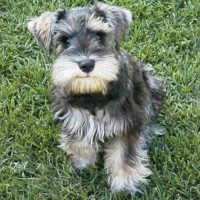Appearance of the Snorkie
|
| Realistically, despite their different origins, Yorkies and Mini Schnauzers aren't that different in physical appearance. This makes the Snorkie's appearance more uniform than many other hybrid dogs. Although there are inevitable variations in appearance, most Snorkies resemble slightly larger and grayer Yorkshire Terriers. Most will have a longer muzzle than a Yorkshire, with a neat black nose at the tip. Their eyes are dark brown and circular, with an alert, friendly expression. Dogs can have the high, floppy ears of the Schnauzer, the smaller, erect ears of the Yorkshire, or an ear type that falls somewhere in between. Their body is small but compact, with well-proportioned limbs. Their tails are short to medium and densely hairy. The coats of both parent dogs can be high-maintenance, and the Snorkie's coat is no exception. Their coat is long and silky and they can have a dense undercoat. While many have the salt-and-pepper gray coat of the Schnauzer, some will have a brown and black coat. Hair shedding is minimal in this breed. A small dog, most will measure less than 30 centimeters at maturity, the smallest adult dog barely reaching 14 centimeters. At maturity, the Snorkie will weigh between 3.5 and 5.5 kilos. |
Temperament of the Snorkie
|
| A sociable character, the Snorkie enjoys spending time in the company of humans and other dogs. They become closely bonded to their families and are generally very loyal. Although they do very well with children at home, their small size means they need to be supervised when playing with toddlers and young children. Some dogs may have a tendency to chew or nip, which means that both dog and child need appropriate training from the outset to avoid any undesirable situations. A very alert dog, whose ancestors were used for guarding, the Snorkie makes a suitable watchdog. They'll bark and yelp at the first sign of something happening. Of course, they're too small to make an effective defense dog, so you shouldn't count on them to fulfill this function. Likewise, they tend to be entirely barkers and rarely show any signs of real aggression or hostility. With both parent dogs previously acting as ratter, it's not surprising that the Snorkie can have a strong hunting streak and likes to chase anything that moves. This makes them unsuitable companions for small animals, such as rabbits or gerbils. |
Needs and activities of the Snorkie
|
| The Snorkie will benefit from a daily walk and a game of fetch. He's an active little dog who loves to play. Obedience classes are a great way to teach Snorkie your manners. Classes are also a great way to socialize him so he learns to play well with other dogs. This little dog will also enjoy an afternoon at the dog park, where he can run, play and interact with other dogs. At the end of the day, Snookie is happy to snuggle up next to his beloved owner and be petted. He's adaptable to life in an apartment or home, although his vocal skills make him less suited to staying in close quarters, such as an apartment. |
Maintenance of the Snorkie
|
| The Snorkie requires daily brushing or its fur will develop mats. His coat is a double coat and extremely silky, so a smooth brush will glide well. A little combing afterwards can also be beneficial. Some owners take their dogs to a groomer, and their trimming will be short. You should also wipe his ears once a week to remove any debris. They can accumulate small amounts of dirt, which you can clean with a warm cloth. Some owners brush their dog's teeth every two or three days to keep his breath pleasant and remove plaque. His nails may wear naturally if you walk him every day, but if not, you can trim them. |









 English (United Kingdom)
English (United Kingdom)